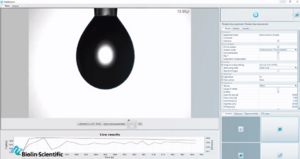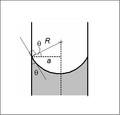Young–Laplace equation facts for kids
The Young–Laplace equation is a special math rule in physics. It helps us understand the pressure difference across the surface where two still liquids meet, like water and air. This pressure difference happens because of something called surface tension. Think of surface tension as a thin, stretchy skin on the liquid's surface.
This equation is super important for studying how liquids behave when they form curved surfaces, like a drop of water or a bubble. In the study of the human body (called physiology), this rule is known as Laplace's law. It helps explain the pressure inside organs that are hollow, like your lungs or blood vessels.
The equation is named after two smart scientists. Thomas Young first thought about surface tension in 1805. Then, Pierre-Simon Laplace finished the math for it the next year. Sometimes, another scientist, Carl Friedrich Gauss, is also mentioned because he brought all their ideas together in 1830.
Contents
What is Surface Tension?
Surface tension is like an invisible film on the surface of a liquid. It makes the liquid try to shrink into the smallest possible shape, like a sphere. This is why water drops are round. The Young-Laplace equation helps us measure how strong this "film" is.
How Does It Work?
Imagine a tiny bubble or a water droplet. The Young-Laplace equation connects the pressure inside the bubble or droplet to the pressure outside. It also considers how curved the surface is and how strong the surface tension is.
- Pressure Difference: The equation shows that the pressure inside a curved liquid surface is different from the pressure outside.
- Surface Shape: It links this pressure difference to the exact shape of the liquid's surface.
- Surface Tension: The stronger the surface tension, the bigger the pressure difference for the same curve.
Why is it Important?
This equation helps scientists and engineers in many ways:
- Designing tiny devices: It's used in making very small devices where liquid behavior is key.
- Understanding nature: It explains how water moves in soil or how sap moves up plants.
- Medical science: In medicine, it helps understand how lungs work or how blood flows in tiny vessels.
Young, Laplace, and Gauss
The Young-Laplace equation is a great example of how scientific ideas grow over time.
- Thomas Young was a British scientist who first described the idea of surface tension. He noticed how liquids behave at their edges.
- Pierre-Simon Laplace was a French mathematician. He took Young's ideas and turned them into a detailed mathematical equation.
- Carl Friedrich Gauss was a German mathematician. He later made the equation even more complete and showed how it connected to other physics rules.
These scientists helped us understand the amazing world of liquids and how they interact with their surroundings.
Images for kids
See also
 In Spanish: Ley de Laplace para niños
In Spanish: Ley de Laplace para niños



